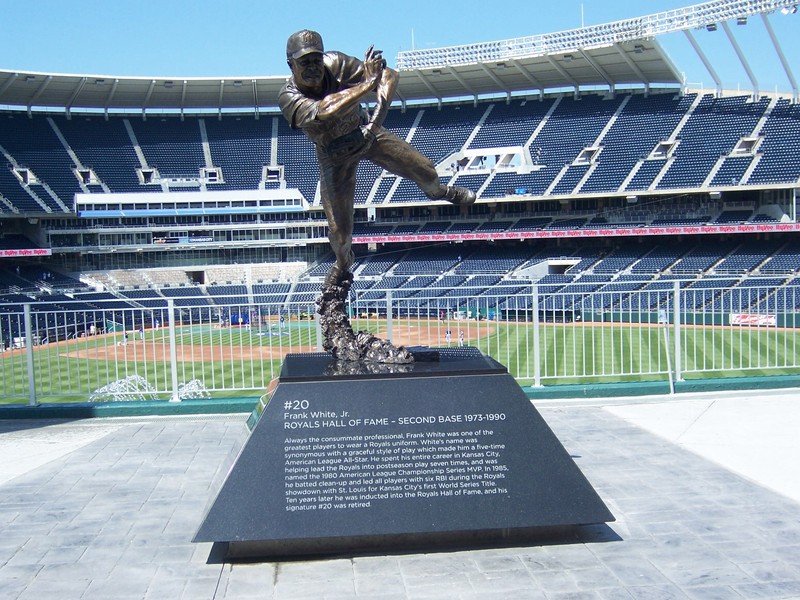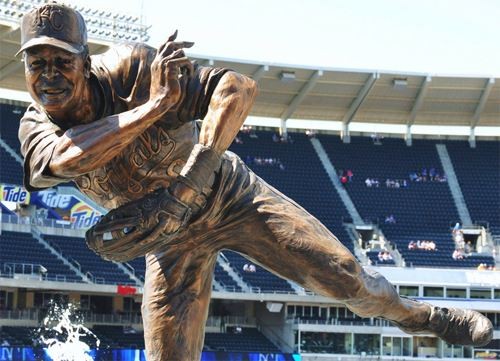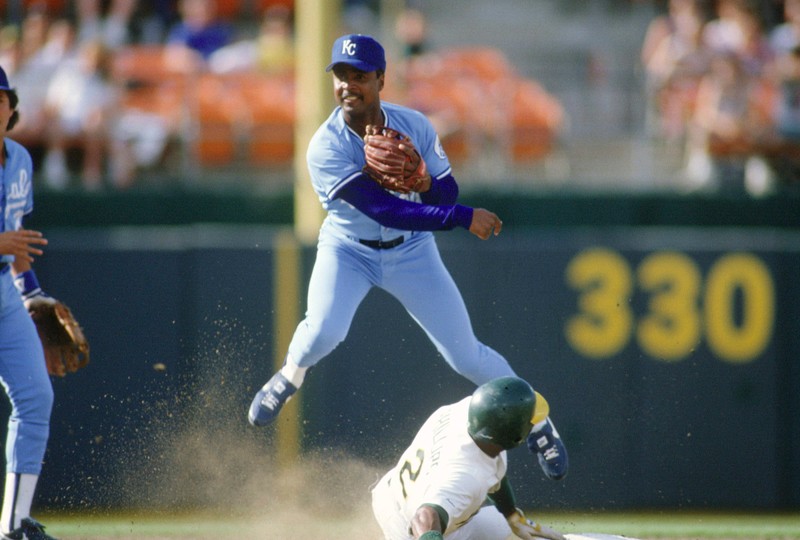Frank White Statue
Introduction
Text-to-speech Audio
This statue commemorates former Kansas City Royals second baseman, Frank White (1950-). A native of Mississippi who grew up in Kansas City, he spent his entire eighteen-year major league career with the Royals. In that time, White made a case for being one of the best second basemen of all time. During his career, he won eight Gold Glove Awards and one Silver Slugger Award. White also led all American League second basemen in fielding percentage three times. In the 1980 American League Championship Series (ALCS), he hit .545 to win the ALCS Most Valuable Player Award and power the Royals past the New York Yankees to a World Series appearance. Five years later, in the 1985 World Series, White collected six RBIs to help the club defeat the St. Louis Cardinals in seven games and clinch the franchise’s first World Series title. Following the 1990 season, the five-time All-Star retired, finishing his lengthy big league career with 2,006 hits, 886 RBIs, and a batting average of .255. On July 31, 2004, the Royals unveiled a statue of White outside Kauffman Stadium. Designed by world-renowned artist Harry Weber, who later designed the statues of the Kauffmans and former Royals manager Dick Howser, the life-sized bronze sculpture depicts the club’s former second baseman in action on the diamond. Dressed in his Royals uniform, he contorts his body in mid-air to throw the ball to first base, as if avoiding a sliding opponent to turn a double play. In 2009, after Kauffman Stadium underwent significant renovations, the organization moved the statue, along with that of George Brett, inside the ballpark to the new right centerfield concourse.
Images
Frank White Statue in Kauffman Stadium's right centerfield concourse

A closer look at the bronze sculpture

Frank White (1950-)

Backstory and Context
Text-to-speech Audio
Frank White, Jr. was born on September 4, 1950 in Greenville, Mississippi. His father was a Greenville-born World War II veteran who played amateur baseball. His mother was the daughter of Mississippi Delta sharecroppers. When White was six years old, he and his family moved north to Kansas City. There, his father found work at various automotive dealerships, while his mother labored in the city’s Garment District. White learned the game of baseball from both his father and the pick-up games that he played with the neighborhood kids before beginning to participate in organized baseball at the age of nine. Later, he attended Lincoln High School, where he was a member of the school’s basketball and football teams. Since the school lacked a baseball team, White honed his skills on the diamond playing in the Connie Mack and Ban Johnson leagues. After graduating from high school in 1968, he worked for Hallmark Cards and Metals Protection Plating in Kansas City, and briefly attended Southern University in Baton Rouge, Louisiana. In 1970, White attended a tryout at Municipal Stadium for the Kansas City Royals baseball newly opened baseball academy in Florida. After impressing with his raw athletic ability, he earned a spot at the academy.
Later that same year, White signed a contract with the Royals and began playing in the club’s farm system, spending time with the organization’s minor league affiliates in Jacksonville, Omaha, and San Jose. In the middle of the 1973 season, he received that for which all minor league prospects hope, a call-up to the major leagues. White ultimately remained with the Royals for the entirety of his eighteen-year big league career. In that time, he made a case for being one of the best second basemen of all time. During his career, White won eight Gold Glove Awards and one Silver Slugger Award. He also led all American League second basemen in fielding percentage three times. In the 1980 American League Championship Series (ALCS), White hit .545 to win the ALCS Most Valuable Player Award and power the Royals past the New York Yankees to a World Series appearance. Five years later, in the 1985 World Series, he collected six RBIs to help the club defeat the St. Louis Cardinals in seven games and clinch the franchise’s first World Series title. Following the 1990 season, the five-time All-Star retired, finishing his lengthy major league career with 2,006 hits, 886 RBIs, and a batting average of .255.
On July 31, 2004, the Royals unveiled a statue of White outside Kauffman Stadium. Designed by world-renowned artist Harry Weber, who later designed the statues of the Kauffmans and former Royals manager Dick Howser, the life-sized bronze sculpture depicts the club’s former second baseman in action on the diamond. Dressed in his Royals uniform, he contorts his body in mid-air to throw the ball to first base, as if avoiding a sliding opponent to turn a double play. In 2009, after Kauffman Stadium underwent significant renovations, the organization moved the statue, along with that of George Brett, inside the ballpark to the new right centerfield concourse.
Sources
Bogovich, Rich. "Frank White." sabr.org. Society for American Baseball Research. Web. 5 August 2021 <https://sabr.org/bioproj/person/frank-white/>.
"Frank White." harryweber.com. Harry Weber Official Website. Web. 5 August 2021 <http://harryweber.com>.
"Frank White." mlb.com. The Royals Hall of Fame. Web. 5 August 2021 <https://www.mlb.com/royals/hall-of-fame/members/frank-white>.
Porter, David L., ed. Biographical Dictionary of American Sports. Baseball, Q-Z. Westport, CT: Greenwood Press, 2000.
https://crownsportsauction.com/frank_white_hall_of_fame_statue___17_20-lot4289.aspx
https://www.jacksongov.org/Government/Elected-Officials/County-Executive
https://royalsreporter.com/2020/06/04/frank-white-the-kc-story-1986-and-the-royals-divorce/
